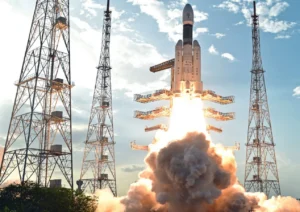GS 3 – Science and technology

Context:
The Indian Space Research Organisation (ISRO) is developing its most powerful rocket yet—the Lunar Module Launch Vehicle (LMLV)—to boost India’s capabilities in space exploration.
Highlights
- Primary Purpose: LMLV is designed for lunar missions and aims to support India’s first human landing on the Moon by 2040.
- Replacement and Support: This rocket will replace the Next Generation Launch Vehicle (NGLV) plan and contribute to India’s space station program development.
- Size: The LMLV will stand as tall as a 40-story building, much larger than the current LVM-3 model.
Technical Details
- Payload Capacity:
- Up to 80 tonnes to Low Earth Orbit (LEO).
- Up to 27 tonnes to the Moon, suitable for human-rated spacecraft.
- Design:
- Partially reusable super heavy-lift rocket with three stages.
- First two stages use liquid propellants.
- Third stage uses cryogenic propellant.
- Equipped with strap-on boosters taller than the entire LVM-3 rocket, with 27 engines in the first stage (core plus boosters).
- Partially reusable super heavy-lift rocket with three stages.
- Timeline: Expected completion by 2035, reflecting ISRO’s long-term commitment to space exploration.
Future Missions Enabled by LMLV
- Human Lunar Mission (Target 2040): Capable of carrying crew modules weighing 18–20 tonnes for India’s first astronaut landing on the Moon.
- Bharatiya Antariksh Station (BAS): Will support deployment of heavy modules for India’s planned five-module space station by 2035.
- Lunar Cargo Missions: Can transport approximately 27 tonnes to the Moon, aiding infrastructure and logistics development on the lunar surface.
Deep Space Exploration: Heavy-lift capacity enables potential interplanetary missions in the 2040s, extending India’s reach beyond the Moon.




